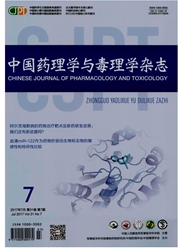

 中文摘要:
中文摘要:
目的 通过对海洛因依赖患者来源的吗啡多抗与多种阿片类物质的结合特异性的研究,分析人源化吗啡抗体识别抗原的关键结构。方法 竞争ELISA法观察海洛因依赖患者血清中吗啡多抗与9种阿片类物质的结合特异性。结果 吗啡多抗与吗啡、海洛因、可待因及吗啡-葡萄糖醛酸苷等阿片受体激动剂有较强的结合性,最大竞争抑制率达到80%~100%,IC50值在1~100pμmol·L“之间;但与[D-Ala^2,N-Me-Phe^4,Gly^5-ol]-脑啡肽和桔抗剂纳洛酮及纳曲酮没有结合。在激动剂中,与抗体亲和力较强的化合物结构均与吗啡相似(6-位醇羟基);美沙酮、羟考酮、埃托啡等6-位取代结构变化较大,与抗体的亲和力也较弱,最大竞争抑制率仅有50%~75%。结论 吗啡抗体主要识别的结构是阿片受体激动剂的活性基团N-甲基,同时分子结构中3-位或6-位取代基对抗体识别也有一定影响。
 英文摘要:
英文摘要:
AIM To investigate the affinity specificity between opiates and the polyclonal anti-morphine antibodies from heroin abusers and determine the dominant domain of antigen that anti-morphine antibodies recognized. METHODS The inhibitory effects of opiates on conjugation between human polyclonal anti-morphine antibodies in serum and morphine-3-glucucoid ( M-3-G )-BSA ( M-3-G-BSA ) were investigated by competitive ELISA. RESULTS In ELISA inhibitory experiments, the antibodies showed high cross reactivities between morphine and heroin, codeine, M-3-G, the maximal ratios of inhibition ranging from 80%-100% and the values of IC50 ranging from 1-100 μmol·L^-1 ; and showed low cross reactivities between morphine and methadone, oxycodone, etorphine, the maximal ratios of inhibition were ranging from 50%-75% and the values of IC50 were larger than 100 μmol·L^-1. Naloxone, naltrexone and [ D-Ala^2, N-MePhe^4, Gly^5-ol ]-enkephalin had nearly no inhibitory effect. CONCLUSION The active groups (N-substituent group ) of agonists of opiate receptors may be the dominant domain that recognized by anti-morphine antibody, while some substituent on morphine nucleus (such as 3-, 6-positions) would affect recognition of anti-morphine antibody.
 同期刊论文项目
同期刊论文项目
 同项目期刊论文
同项目期刊论文
 期刊信息
期刊信息
